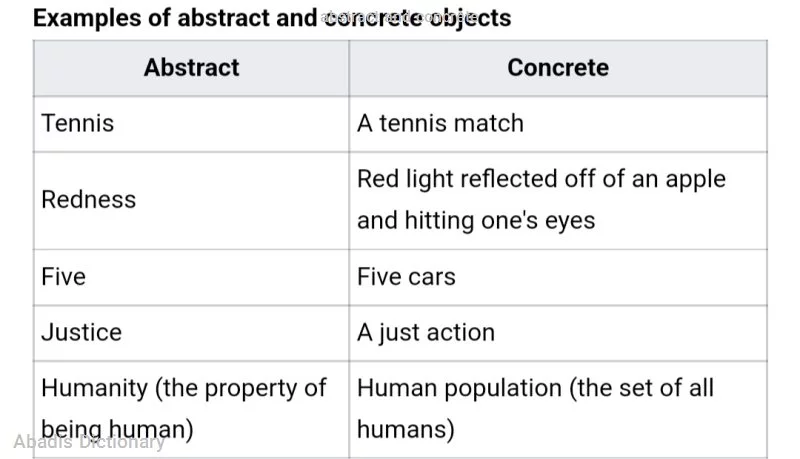انتزاعی و انضمامی دو مفهوم متقابل در فلسفه هستند. امور انتزاعی ( به انگلیسی: abstract ) فرازمانی و فرامکانی هستند مثل اعداد یا موجودات مجرد، اما امور انضمامی ( به انگلیسی: concrete ) ، اموری زمانی و مکانی هستند. انتزاعی در اصل به معنای امر جدا شده، گسسته و مجرد و انضمامی حاوی معانی پیوستگی، گرد هم آمدن و چسبندگی است.
... [مشاهده متن کامل]
ذهن پس از آنکه چند چیز مشابه را درک کرد، آنها را با یکدیگر مقایسه می کند. اوصافی را که مخصوص به هر یک از آن هاست، کنارگذاشته و وجه تشابه و صفت مشترک میان همه آنها را برمی گزیند. سپس از آن صفت مشترک، یک مفهوم کلی می سازد که دربارهٔ همه آن افراد صادق است. در این هنگام گفته می شود که این مفهوم، از این چیزها انتزاع شده و مفهومی انتزاعی است.
برای مثال، چند نفر از دوستانمان را می بینیم. وجوه تمایز، یعنی آن اوصافی راکه هر یک را از دیگران متفاوت می سازد، کنار گذاشته و وجه مشترک میان همه آن ها را که انسانیت است، برمی گزینیم.
اکنون، انسانیت مفهومی کلی است که بر همه آنها صدق می کند؛ بنابراین می گوییم: مفهوم انسانیت از آنها انتزاع شده است. در حالی که اوصاف مخصوص به هر کدام از آن ها با یکدیگر متفاوت است. قد و وزن شخص خاصی را نمی توان بر همه صادق دانست؛ چرا که شخص دیگر، قد و وزن این شخص را ندارد.
به همین ترتیب و بنابر آنچه گفته شد، در می یابیم که انتزاعی ( یعنی انتزاع شده ) همین مفهوم کلی است که از مصادیق خارجی انتزاع شده است؛ مثلاً مفاهیم انسانیت یا حیوان، مفاهیمی انتزاعی هستند. مفاهیم انتزاعی در خارج وجود ندارند، یعنی نمی توان انسانیت را در خارج نشان داد، بلکه ذهن این مفاهیم را در ضمن موجودات به طریقی که گفته شد، در می یابد.
به طور خلاصه، انتزاع، یک فعالیت و عمل ذهنی است که عقل توسط آن، مفهومی را از عالم خارج در می یابد و خود این مفهوم، انتزاعی نامیده می شود.
Metaphysics concept covering the divide between two types of entities
In metaphysics, the distinction between abstract and concrete refers to a divide between two types of entities. Many philosophers hold that this difference has fundamental metaphysical significance. Examples of concrete objects include plants, human beings and planets while things like numbers, sets and propositions are abstract objects. There is no general consensus as to what the characteristic marks of concreteness and abstractness are. Popular suggestions include defining the distinction in terms of the difference between ( 1 ) existence inside or outside space - time, ( 2 ) having causes and effects or not, ( 3 ) having contingent or necessary existence, ( 4 ) being particular or universal and ( 5 ) belonging to either the physical or the mental realm or to neither. Despite this diversity of views, there is broad agreement concerning most objects as to whether they are abstract or concrete. So under most interpretations, all these views would agree that, for example, plants are concrete objects while numbers are abstract objects.
Abstract objects are most commonly used in philosophy and semantics. They are sometimes called abstracta in contrast to concreta. The term abstract object is said to have been coined by Willard Van Orman Quine. Abstract object theory is a discipline that studies the nature and role of abstract objects. It holds that properties can be related to objects in two ways: through exemplification and through encoding. Concrete objects exemplify their properties while abstract objects merely encode them. This approach is also known as the dual copula strategy.
In philosophy
The type–token distinction identifies physical objects that are tokens of a particular type of thing. The "type" of which it is a part is in itself an abstract object. The abstract–concrete distinction is often introduced and initially understood in terms of paradigmatic examples of objects of each kind :

... [مشاهده متن کامل]
ذهن پس از آنکه چند چیز مشابه را درک کرد، آنها را با یکدیگر مقایسه می کند. اوصافی را که مخصوص به هر یک از آن هاست، کنارگذاشته و وجه تشابه و صفت مشترک میان همه آنها را برمی گزیند. سپس از آن صفت مشترک، یک مفهوم کلی می سازد که دربارهٔ همه آن افراد صادق است. در این هنگام گفته می شود که این مفهوم، از این چیزها انتزاع شده و مفهومی انتزاعی است.
برای مثال، چند نفر از دوستانمان را می بینیم. وجوه تمایز، یعنی آن اوصافی راکه هر یک را از دیگران متفاوت می سازد، کنار گذاشته و وجه مشترک میان همه آن ها را که انسانیت است، برمی گزینیم.
اکنون، انسانیت مفهومی کلی است که بر همه آنها صدق می کند؛ بنابراین می گوییم: مفهوم انسانیت از آنها انتزاع شده است. در حالی که اوصاف مخصوص به هر کدام از آن ها با یکدیگر متفاوت است. قد و وزن شخص خاصی را نمی توان بر همه صادق دانست؛ چرا که شخص دیگر، قد و وزن این شخص را ندارد.
به همین ترتیب و بنابر آنچه گفته شد، در می یابیم که انتزاعی ( یعنی انتزاع شده ) همین مفهوم کلی است که از مصادیق خارجی انتزاع شده است؛ مثلاً مفاهیم انسانیت یا حیوان، مفاهیمی انتزاعی هستند. مفاهیم انتزاعی در خارج وجود ندارند، یعنی نمی توان انسانیت را در خارج نشان داد، بلکه ذهن این مفاهیم را در ضمن موجودات به طریقی که گفته شد، در می یابد.
به طور خلاصه، انتزاع، یک فعالیت و عمل ذهنی است که عقل توسط آن، مفهومی را از عالم خارج در می یابد و خود این مفهوم، انتزاعی نامیده می شود.

